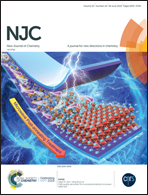A turn-on fluorescent probe for sensitive detection of ascorbic acid based on SiNP–MnO2 nanocomposites†
Abstract
Ascorbic acid plays a crucial role in biochemical processes as a scavenger for preventing oxidative damage. Herein, a sensitive and selective fluorescent biosensor for the detection of ascorbic acid was proposed based on green-emission fluorescent silicon nanoparticles (SiNPs) and bovine serum albumin (BSA) templated-MnO2 nanosheets. Green-emission fluorescent SiNPs have been synthesized by a facile one-pot reduction reaction at room temperature by using DAMO and 3-hydroxytyramine hydrochloride as the silicon source and the reactants, respectively. The fluorescence of the SiNPs could be effectively quenched by MnO2 nanosheets. When ascorbic acid is introduced, the MnO2 nanosheets are reduced to Mn2+ ions by ascorbic acid, resulting in the fluorescence recovery of SiNPs. This sensing system exhibits a good linear range for ascorbic acid detection from 1 to 400 μM with a detection limit of 0.102 μM. Meanwhile, the detection system also exhibits high selectivity against other possible co-existing species. The present sensor was successfully applied for the detection of ascorbic acid in a commercially available vitamin C supplement, suggesting this sensing system holds great potential in food safety and disease diagnosis.



 Please wait while we load your content...
Please wait while we load your content...